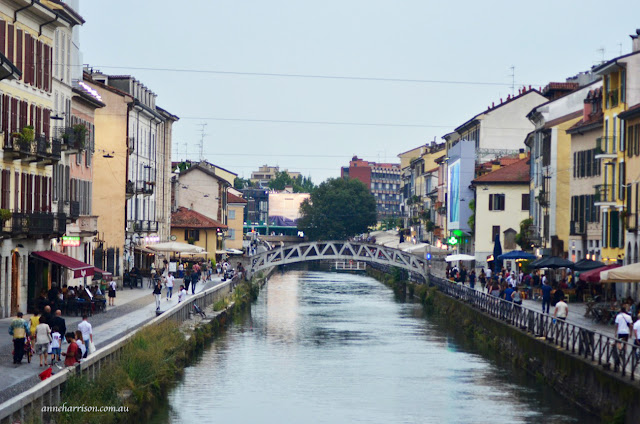 |
| Milan Cathedral |
I emerged from the underground at the Piazza Duomo, which is the palpable heart of Milan. Being the fourth largest cathedral in Europe, the Duomo dominates the piazza cathedral. It is a stunning piece of architecture, and inside proves a veritable art gallery. Don't miss going up on the roof to walk on the cathedral terraces.
 |
| Galleria Vittorio Emanuele II |
I could spend hours just window shopping in the Galleria Vittorio Emanuele II - the window displays are stunning. With the likes of Gucci and the Milanese Prada dominating, I was content to sit with a coffee and a panini, and watch the world walk by.
 |
| Evening in the Navogli district |
Rain started falling as I caught the metro to the Navogli area. Suddenly hawkers appeared selling umbrellas - where do they hide, to suddenly emerge so laden? Many of the canals were covered to build space for trams and roads, but the council is considering digging them up again, to make Milan more like Venice once more (perhaps something to do with the tourist dollar?)
 |
| Modern art |
Art is everywhere in Italy. Simply wander the streets, and you cannot miss it - the buildings, the architecture, statues, even the layout of the streets, vistas opening onto fountains. Even the train station is stunning. A remarkable feat, considering how much of the city was destroyed during WWII. Plus there is always something new. Such as a needle and thread.
 |
| Leonardo's Last Supper |
The Literary Traveller
As the centenary of the end of WWI draws nigh, Hemingway's A Farewell to Arms is worth revisiting. It goes beyond the futility, the absurdity and the banality of war to exploring the tragedy of human existence. Much of the tale comes from Hemingway's own experiences as an ambulance driver in Italy during the war. The novel follows the experiences of Lieutenant Frederick Henry; when he is wounded he is sent to Milan to recover, and much of the story takes place here. The novel was banned in Italy until 1948. Many critics cite A Farewell to Arms as Hemingway's best work.
Like my photos? - please click link to buy either my photos from the microstock site 123RF, or products from my store, EnsoCreations
Comments
Post a Comment